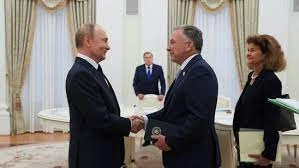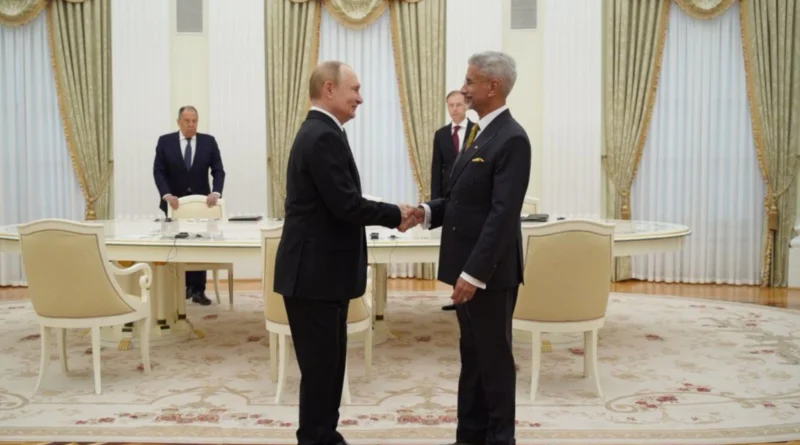India’s ‘Prisoner’s Dilemma’ in Trump’s ‘Game of Chicken’ on Russian Oil, and the Hobson’s Choice Presented by China
India’s foreign policy is entering a complex phase as global power rivalries sharpen. External Affairs Minister S. Jaishankar recently expressed surprise over the additional 25 per cent US tariff on India’s energy imports from Russia. He pointed out that it was Washington itself that once encouraged countries, including India, to buy Russian oil to stabilise global energy markets.

Yet, beneath the diplomatic exchanges, there is a deeper realisation in New Delhi’s policy circles: India may have become a “soft target” in US President Donald Trump’s larger strategy. As Washington seeks to squeeze Moscow’s oil revenues and force Russia to negotiate on ending the war in Ukraine, India is caught in a strategic bind — one that analysts describe as a prisoner’s dilemma.
Trump’s ‘Game of Chicken’ with Russia
The US has chosen energy as its weapon of choice against Moscow. By hitting Russian crude exports with tariffs and restrictions, Washington hopes to weaken Russia’s war chest. Analysts like David Woo, former head of global economics research at Bank of America, argue that squeezing oil revenues was seen in Washington as the “cheapest and easiest way to weaken Russia.”
Trump’s approach resembles a high-stakes “game of chicken,” where both sides race toward a collision, hoping the other swerves first. By pressuring oil buyers like India, Washington believes it can reduce Russia’s leverage and force Moscow to the negotiating table.
But for India, this strategy creates uncomfortable risks. The country relies heavily on Russian oil, which is often cheaper and more accessible than alternatives. Cutting imports could hurt India’s energy security and raise domestic prices.
India as a “Soft Target”
From New Delhi’s perspective, the tariffs feel like collateral damage. India has consistently argued that its purchases of Russian oil are essential for stabilising its economy and meeting the energy needs of 1.4 billion people.
Despite this, Washington has chosen to single out India with new tariffs. Many in New Delhi believe this is because the US sees India as easier to pressure compared to China, which remains largely off-limits in Washington’s strategy.
This has led to growing unease in Indian policy circles. The fear is that India could end up paying the price for a conflict it did not create, while bigger powers like China escape similar scrutiny.
China’s Hobson’s Choice
Adding to India’s dilemma is China’s position. While Washington pressures New Delhi on Russian oil, Beijing is presented with what experts call a Hobson’s choice — a decision where there is really no choice at all.
China has deep trade ties with both the US and Russia. Unlike India, Beijing cannot easily be pressured into reducing energy imports from Russia because its economy is too intertwined with global supply chains. From Washington’s point of view, directly targeting China is too risky.
This creates an imbalance: India faces tariffs and pressure, while China continues to expand its economic influence without facing the same penalties.
The ‘Prisoner’s Dilemma’ for India
The situation has been described by analysts as a classic “prisoner’s dilemma.”
- If India cuts back on Russian oil imports to avoid US tariffs, it weakens its own energy security and raises costs at home.
- If India continues importing Russian oil, it risks worsening tensions with Washington and being seen as undermining global sanctions against Moscow.
Either way, India pays a price. Unlike China, which has greater bargaining power, India finds itself in a position with limited choices.
Expert Opinions
Economists and foreign policy experts agree that India’s position is challenging. David Woo and other analysts argue that Washington views oil as the simplest way to squeeze Russia. But in practice, this means partners like India are caught in the crossfire.
Some Indian strategists warn that the country must diversify its energy sources and reduce dependence on any single supplier. Others believe India should negotiate harder with Washington, using its role as a key US ally in Asia to secure exemptions or relief from tariffs.
Global Energy Politics at Play
The clash over Russian oil is not just about economics — it is about geopolitics.
- For Washington, cutting Russia’s oil revenues is a tool to end the Ukraine war.
- For Moscow, oil exports remain its financial lifeline.
- For India, Russian oil is a way to keep energy prices manageable.
- For China, Russia’s cheap oil helps strengthen its industrial base without direct confrontation with the US.
This mix of interests makes global energy politics more complicated than ever. India’s challenge is to navigate these competing pressures without undermining its national interests.
The Road Ahead for India
Looking forward, New Delhi faces a tough balancing act. On one side, it cannot afford to alienate Washington, given the importance of US-India relations for trade, technology, and defense. On the other, India cannot abruptly cut off Russian oil, which remains vital for its economy.
India’s options may include:
- Negotiating exemptions or reduced tariffs with the US.
- Expanding energy partnerships with the Middle East.
- Investing more in renewable energy to reduce dependence on imports.
Each of these options comes with costs and risks, but they may help India reduce the pressure from Trump’s strategy.
Can India Escape the Dilemma?
India’s “prisoner’s dilemma” in Trump’s “game of chicken” with Russia shows the complexity of global politics in a multipolar world. By targeting oil, Washington hopes to weaken Moscow, but in the process, it risks alienating a key partner like India.
Meanwhile, China faces no such penalties, leaving New Delhi to deal with difficult choices. Whether India can find a middle path — protecting its energy security while maintaining strong ties with Washington — will determine how successfully it navigates this geopolitical storm.
Follow us for more news at Valleynewz.com

